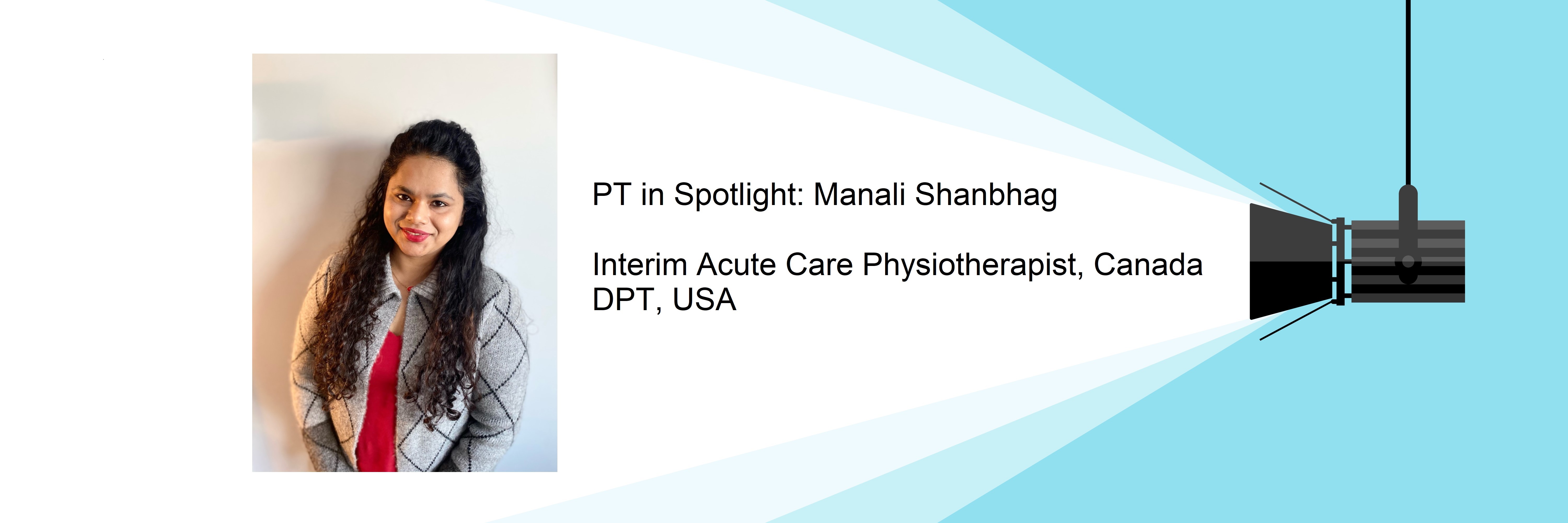
This week’s spotlight features Manali Shanbhag from Canada. Manali completed her post professional DPT from Lomalinda University . After Working in the US for a few years she transitioned to Canada on PR. In this spotlight Manali shares her journey and valuable insights for anyone wanting to transition to US or Canada.
What is your name, job title and workplace?
Hello, my name is Manali Shanbhag.
I am working as an interim acute care physiotherapist at Medicine Hat regional hospital, Alberta, Canada.
What is your educational background?
Bachelor’s in Physiotherapy (BPTh), Sancheti College of Physiotherapy-MUHS, India
Post-professional Doctor of Physical Therapy (PPDPT), Loma Linda University, USA.
Why did you decide to pursue DPT in US?
After graduating with my bachelor’s degree in 2013, I started working in a clinic in Mumbai. During this time I realized although I have a strong knowledge base, I need to add more assessment and treatment techniques to my tool kit, as well as refine the existing ones.
I initially enrolled into few certification courses, but soon realized this was not enough. So, I decided I wanted to get a Master’s degree. I started connecting with my batch mates and seniors, who were either working towards a Master’s or already had one.
Apart from that, I did my own research as well, I found out that a lot of universities around the world have either transitioned or are moving from a Master’s in Physiotherapy/physical therapy to a Doctor of Physical therapy program.
I was also keen on experiencing a different culture. My acquaintances working in the US, commended the work-life balance that the US offered. Due to these reasons I decided to pursue my DPT in the US.
What were the universities you considered?
Loma Linda University, USA
University of Indianapolis, USA
McMaster University, Canada
Why did you choose Loma Linda University?
Loma Linda University was checking all of my boxes; in terms of the degree, I preferred a DPT vs. MPT. They were offering the possibility of a graduate assistant-ship- which meant an on campus part time job. And of course, the opportunity to live in and explore the beautiful state of California for 18 months.
Tell us more about the application process for the course
This list is not exhaustive, but for the initial application most universities needed
- Valid IELTS/TOEFL (each university had different minimum cut off scores)
- WES report
- Professional references
- Statement of purpose
- Letter of Intent
- At some point of securing admission proof of finance
Did you go through any counselor?
Yes, I used GEEBEE Education, Borivali, Mumbai
Tell us more about your course
The PPDPT 66 Unit Track program is an eleven month program. For full-time students like me it was mandatory to take 12 units (or more) per 10-week quarter. The teaching methods were a mix of didactic instruction, lab work, peer learning via group presentations, group assignments. Some credits were delivered via online format as well.
What are the job prospects in the US after DPT?
The job prospects are excellent after DPT. Several employers are seeking PTs who exclusively have a DPT.
Tell us briefly about obtaining a work permit + License in the US after DPT ?
The process to getting licensed in the US is a long road for internationally educated PTs. The first step is to become eligible to take the exam. Me and most of my colleagues had to take additional college credits to fill the gaps in our education, to bring it up to the USA standards. This meant additional cost, more studying on top of our regular coursework.
Once we were deemed eligible to take the national licensing exam- NPTE, we then started the 3-4 month focused study to pass this 4 hour 250 MCQ exam.
On passing the exam, we had to decide which state we wanted to practice in and fulfill specific requirements each state had. Once all this was checked off you would become licensed to practice in that particular state only.
I cannot speak for other professions, but getting a work permit is certainly the most challenging part for international PTs in the US. The process to getting a work permit is to find an employer that will sponsor and file for your visa. Your application then enters a pool and through a lottery the final work visas are awarded.
Editor’s note : Read my article about obtaining physical therapy License on dependent visa in US for more insights about credentialing process.
Why did you transition to Canada?
The luck factor that the lottery system introduces, and the red tape that I had to push through to keep renewing the work visa, was the biggest reason that led me to move and settle in Canada.
What was the process like to obtain a license in Canada? The process is somewhat similar to that of the US.
Get credentialing done- This involves submitting documents like your degree, transcripts, details of your coursework to Canadian Alliance of Physiotherapy Regulators (CAPR) to prove that your degree and education are at par with Canadian standards. I also had to take the academic IELTS or TOEFL again as my previous score had expired.
Once approved by CAPR you can take the PCE which is the license exam for Canada.
The difference between the NPTE and PCE though is that the PCE has two components – written and clinical.
What was the process like to obtain a work permit in Canada?
I did not have to apply for a work permit because I moved as a Permanent Resident to Canada.
How long did it take you to start working in Canada?
I could not work as a Physiotherapist until I had cleared at least the written component of the PCE, but I worked as a Physiotherapy assistant for 6 months before taking and passing my exam in May 2021. I started working as an Interim Physiotherapist in July 2021.
Interim because I haven’t taken the clinical component yet . This just means I have to work under the supervision of a fully registered physiotherapist, until I pass the clinical.
It is worth mentioning, unlike my situation in US on a work permit, I wasn’t restricted to working only within my field of study in Canada due to having a PR card.
Essentially I could work any job, and I know many people take up temporary jobs to get an income started till they find something within their field.
Can you elaborate on similarities and differences in physiotherapy practices in the US, Canada and India?
One major difference is that Physiotherapy is a strictly regulated profession. You not only need to get licensed but complete continuing education courses to keep your license active both in USA and Canada.
The assessment and treatment techniques don’t vary a lot but there is a big emphasis on patient safety, reporting and documentation of any incident, protection of patient information and confidentiality.
Also in the US and Canada there are different areas of practice like home health, inpatient rehab, skilled nursing facilities and long term care homes. I know some of these have started in India as well, but these are fairly new.
What is the advice you would give to PT students who want to relocate to the US or Canada?
I would tell them that while it is great to have clarity about what you want to do, don’t be rigid, be ready to adapt.
Be prepared to become a well rounded clinician, but also be prepared to acquire life skills like learning to drive, cook, manage your time and finances if you don’t already.
I am passionate about rural healthcare, and would advice the incoming PT students to have an open mind to serving in small and mid sized towns instead of gravitating towards metropolitan cities only.
Where can people reach you?
Related Articles:
Masters in Exercise and Nutrition Sciences, USA | Mrunmayee Dixit
Hello, My name is Tejashree Limaye. I am a physiotherapist with 10+ years of experience. I help you go from being stuck in your career to finding a job you love! I provide career guidance about clinical and non clinical PT career in India. I also help you with US PT licensing process. Welcome to my blog, I hope you find the exact guidance you have been looking for!
